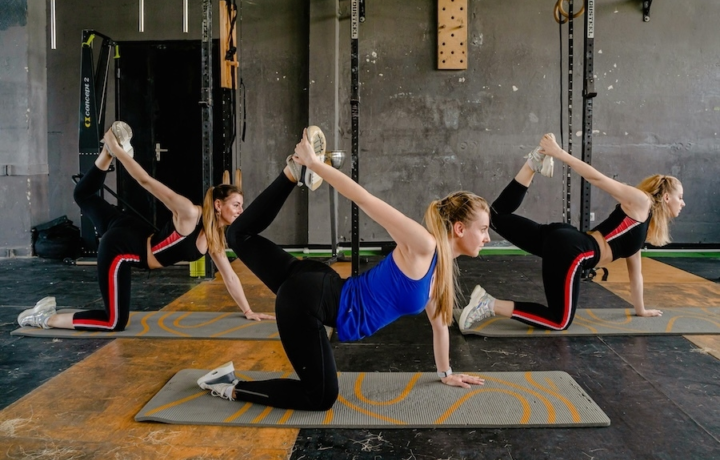Exercise
Extension Of Arms In Vertical Stretch

Extension Of Arms In Vertical Stretch
How to Perform
- Stand with your feet shoulder-width apart, maintaining a neutral spine with your shoulders relaxed and arms at your sides.
- Engage your core and maintain a slight bend in your knees to protect your lower back during the movement.
- Inhale deeply as you slowly raise both arms in front of your body, keeping them straight but not locked at the elbows.
- Continue raising your arms upward until they're fully extended overhead, with palms facing each other and biceps close to your ears.
- At the top position, press your arms slightly back to activate your shoulder muscles while maintaining your ribcage position and avoiding arching your lower back.
- Hold the fully extended position for 1-2 seconds while focusing on reaching toward the ceiling with your fingertips and maintaining proper posture.
- Exhale as you slowly lower your arms back down in front of your body, maintaining control throughout the descent.
- Return to the starting position with your arms at your sides, keeping your shoulders relaxed and down away from your ears.
Important information
- Keep your shoulders down and away from your ears throughout the entire movement to prevent unnecessary tension in your neck.
- Maintain a neutral spine position and avoid arching your lower back as you raise your arms overhead.
- If you feel any shoulder discomfort, reduce your range of motion by not raising your arms fully overhead.
- Focus on the quality of movement rather than speed, ensuring proper form with each repetition.

Extension Of Arms In Vertical Stretch
Exercise Details
Primary Muscles
Muscle Groups
Mechanic
Built for progress
Take the guesswork out of training
Create personalized AI-powered workout plans that evolve with you. Train smarter, track every rep and keep moving forward, one workout at a time.






The Extension of Arms in Vertical Stretch offers a gentle yet effective way to open the shoulders and create space in the often-compressed front and side deltoid muscles. This accessible movement is perfect for beginners looking to improve upper body mobility without complex techniques or equipment. As you reach upward, the front deltoids (which frequently tighten from daily activities like computer work and driving) experience a much-needed release and lengthening. The beauty of this stretch lies in its versatility.
Whether you're warming up before an intense shoulder workout, cooling down after upper body training, or simply taking a break during a long day of desk work, this movement delivers immediate relief to the shoulder complex. The vertical nature of the stretch works against gravity, creating natural resistance that helps improve shoulder mobility over time. For those in recovery phases or dealing with minor shoulder discomfort, this gentle stretching motion can promote blood flow to the deltoid region without aggravating sensitive tissues. The movement encourages synovial fluid movement within the shoulder joint, potentially reducing stiffness and supporting the body's natural healing processes.
This stretch particularly shines as part of a comprehensive mobility routine, as it directly addresses the limited overhead range of motion many people develop through modern lifestyles. Regular practice can progressively improve shoulder function, potentially reducing the risk of impingement issues and creating better movement patterns for everyday activities and athletic endeavors. Remember that consistency trumps intensity with this stretch. A gentle, mindful approach performed regularly will yield better results than aggressive, occasional stretching. The Extension of Arms in Vertical Stretch represents a fundamental movement pattern that supports shoulder health, posture improvement, and upper body function: making it a valuable addition to any fitness regimen regardless of your experience level or specific goals.
FAQ - Extension Of Arms In Vertical Stretch
This stretch primarily targets the front and side deltoid muscles while also engaging the upper trapezius and portions of the pectoral muscles. The vertical reaching motion effectively releases tension that accumulates in these areas from daily activities like computer work and driving.
Stand tall with feet hip-width apart and extend both arms overhead, reaching actively through your fingertips while keeping your shoulders relaxed away from your ears. Maintain a neutral spine position (avoid arching your lower back) and hold for 15-30 seconds while breathing deeply, focusing on creating length rather than straining.
This can be suitable for mild shoulder issues when performed gently, as it promotes blood flow without aggressive movement. However, if you experience pain (not just mild discomfort) during the stretch, lower your arms to a pain-free position or consult with a physical therapist before continuing.
For optimal shoulder mobility, perform this stretch 1-2 times daily, especially if you spend long hours at a desk. Include it both as part of your pre-workout warm-up and post-workout recovery routine to maximize its benefits and progressively improve your overhead range of motion.
The most common errors include shrugging your shoulders toward your ears, overarching your lower back to compensate for limited shoulder mobility, and stretching too aggressively. Focus on quality over intensity, keep your core engaged to protect your spine, and remember that consistent, gentle stretching yields better results than occasional forceful attempts.









